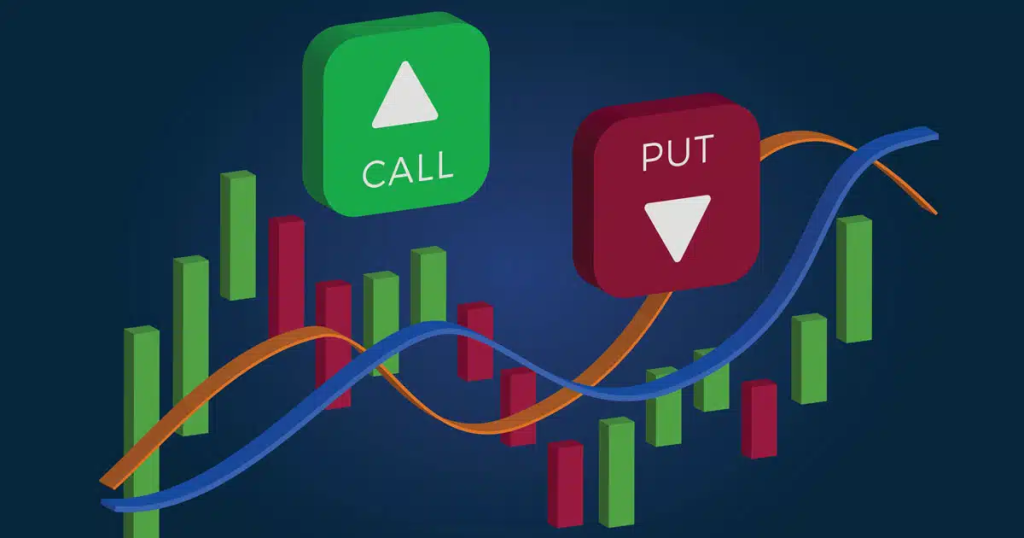Option trading provides traders the flexibility to benefit from market movements or hedge existing positions without owning the underlying asset directly. It can be highly rewarding but also carries significant risks. Before you begin option trading, it is essential to understand key factors that will help you navigate this complex area of the financial markets. This article explores important considerations for beginners, along with the difference between futures and options to offer a clearer perspective.

What is option trading?
In options trading, you trade contracts that give the buyer the right (but not the obligation) to buy or sell an underlying asset (such as stocks or indices) at a pre-set price (strike price) on or before a specific date (expiration date). These contracts come in two main forms:
- Call Options – These give the holder the right to buy the underlying asset at the strike price.
- Put Options – These give the holder the right to sell the underlying asset at the strike price.
Both call and put options enable traders to take chance on price movements or hedge their positions. However, options are more complex than regular stock trading, and understanding the risks and strategies involved is crucial.
Difference between futures and options
Before delving into option trading, it’s helpful to understand the difference between futures and options, as they are both types of derivative contracts.
- Futures contracts require both the buyer and seller to execute the transaction at a future date, regardless of market movements. The contract obligates both parties to settle the trade on the agreed date.
- Options contracts, on the other hand, give the buyer the right (but not the obligation) to complete the transaction. This flexibility makes options attractive to traders seeking risk control, but it also requires the buyer to pay a premium for this right.
The key difference is that futures impose a binding commitment, while options offer more flexibility to the buyer without the obligation to execute.
Read Also:
- Understanding the Indian Forex Market and How to Start Trading in India
- Top 10 Tax Saving Mutual Funds in India
Key factors to consider before starting option trading
If you’re considering option trading, there are several important factors to take into account. These will help you prepare for the complexities and risks involved in this type of trading.
1. Understand the risks
Options come with higher risk than traditional stock trading. For example, buying an option can result in losing the entire premium paid if the market moves in the opposite direction or if the option expires worthless. Selling options (writing options) can also expose traders to substantial losses, particularly with uncovered (naked) options.
It’s important to assess your risk tolerance before entering the options market and to have a well-planned strategy that mitigates potential losses.
2. Time decay impacts your strategy
Options are time-sensitive assets. As they approach expiration, their value decreases due to time decay. This means the longer you hold an option, the more value it can lose, especially if the underlying asset’s price remains stable.
Understanding how time decay impacts your options trading strategy is crucial. For instance, if you’re holding a short-term option, you may need to act swiftly if the market moves in your favour, or risk losing the premium due to time decay.
3. Know the role of volatility
Volatility plays a significant role in option pricing. Implied volatility refers to the market’s forecast of the asset’s potential price fluctuations. Higher volatility generally leads to higher option premiums, but also greater risk.
When volatility is high, options become more expensive, but they also offer greater profit potential if the market moves sharply. If volatility is low, options tend to be cheaper but come with limited profit opportunities. It’s important to monitor volatility to determine if an option is priced fairly and aligns with your strategy.
4. Choosing the right options strategy
Options trading offers a variety of strategies depending on your market outlook and risk tolerance. Some popular strategies include:
- Long Call or Put: Used when you expect a significant price movement in the underlying asset.
- Covered Call: Selling a call option while holding the underlying asset to generate extra income.
- Protective Put: Buying a put option to protect against losses in the underlying asset.
- Straddles and Strangles: These involve buying both a call and a put option simultaneously to profit from large market swings in either direction.
Choosing the right strategy depends on your market forecast, risk tolerance, and investment goals.
5. Account for costs and fees
Unlike traditional stock trading, option trading comes with additional costs. You need to account for:
- Premiums: The price you pay for buying an option.
- Brokerage fees: These fees are typically higher for option trading than for stocks.
- Exercise/assignment fees: Costs incurred when an option is exercised or assigned.
Make sure you understand all the potential costs involved, as they can significantly affect your overall profitability.
Key considerations for option traders
1. Leverage risk
While leverage can amplify your profits, it can also magnify your losses. It’s essential to use leverage carefully and never risk more than you can afford to lose.
2. Risk management
Effective risk management is crucial in option trading. Use tools like stop-loss orders to minimise your exposure. Diversifying your positions and limiting the capital you allocate to any single trade will help protect your portfolio from significant losses.
3. Position sizing
One of the key rules of option trading is proper position sizing. This involves determining how much of your capital you should allocate to each trade. A good rule of thumb is not to risk more than a small percentage of your total capital on any single trade.
Conclusion
Option trading offers great flexibility and the potential for high returns, but it comes with inherent risks. Understanding the difference between futures and options, as well as factors like time decay, volatility, and the different strategies available, is critical before you begin. By considering these key factors and using effective risk management techniques, you can navigate the world of options trading with more confidence and control.

Hi, I’m Dev Kirtonia, Founder & CEO of Dev Library. A website that provides all SCERT, NCERT 3 to 12, and BA, B.com, B.Sc, and Computer Science with Post Graduate Notes & Suggestions, Novel, eBooks, Biography, Quotes, Study Materials, and more.









